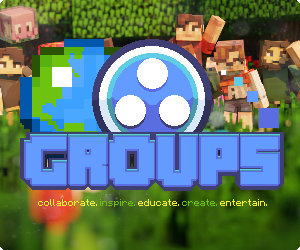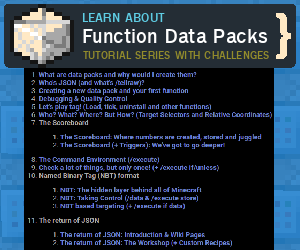- 32,184 views, 2 today
- 30
- 12
- 32
75
In 1.4 (and the pre-releases), the way superflat worlds work completely changed. Gone are the days where you can only have a boring plains world - now you can change just about anything!
Using a special code, you can tell Minecraft how to generate the world. At first, the code looks complicated, however, it's actually easier to understand than it looks.
While at first the code may look confusing and like a load of random numbers and letters, it's pretty simple after a bit of practice using them. Each and every code is formatted like this:
Version number;LayersxBlock ID,LayersxBlock ID;Biome;Extra Stuff,Extra Stuff
"So, what do I put in version number and what is a block ID?" I hear you ask. Well, let me explain all.
Remember when Minecraft was released and all the old seeds stopped working? Well, this is here to stop that happening with superflat codes. The version number forces whatever version of Minecraft you have to generate the superflat world as if it was the version that you put the code in for. For now, you're going to want to put 2 as your version number, as that's what it is for 1.4
Starting at layer 0, this tells the map how to generate. If you only wanted to have one layer of something, then you just need to put the block ID, not the [layers]x bit.
For example, pretend you wanted to generate a world like the old superflat worlds: bedrock at the bottom, 2 layers of dirt then one layer of grass. You'd put 7,2x3,2 in this section. It's basically saying put one layer of 7 (bedrock) down, then 2 layers of 3 (dirt), and then one layer of 2 (grass).
You can see a full list item ID's here.
Each biome has a number, and you can add the number here to choose the biome that you want the map to generate as. You just have to put the number, nothing else.
You also can't generate different parts of a map as different biomes - the whole thing can only be one.
Remember how you used to not get trees in superflat and only get villages? Well, that is no more. Using the extra stuff section of the code, you're able to add things back in that are usually missing. Simply look at the list below, and type the italic word into the extra stuff section.
You can also add parameters to change how villages spawn like this: village(size=[0/1] distance=#)
For size, 0 is default and 1 is superflat default (bigger). The larger the distance, the further away villages will be from each other. Here's an example: village(size=0 distance=100)
Mineshafts also have a parameter: chance, which decides how common they are. 0.0 is the lowest, while 1.0 is the highest. It's parameters are formatted like this: mineshaft(chance=[0.0-1.0]) and an example one is mineshaft(chance=0.5).
Using the "count" parameter, you can decide how many strongholds will spawn in your world. For example, stronghold(count=2) will cause two strongholds to spawn.
So, now all of the different parts of the code are complete, we need to piece the whole code together. Here's an example of a completed code (still color coded):
2;2x49,46,2;1;dungeon,stronghold(count=3),decoration
Which means: version 2; 2 layers of obsidian, 1 layer of TNT, 1 layer of grass; biome 1 (plains);spawn dungeons, 3 strongholds and decorations.
Hopefully it all makes sense now. If for whatever reason you're still unsure about how part of a code works, then feel free to post in the comments below and I'll try and explain it to you. :)
Using a special code, you can tell Minecraft how to generate the world. At first, the code looks complicated, however, it's actually easier to understand than it looks.
The code itself
While at first the code may look confusing and like a load of random numbers and letters, it's pretty simple after a bit of practice using them. Each and every code is formatted like this:
Version number;LayersxBlock ID,LayersxBlock ID;Biome;Extra Stuff,Extra Stuff
"So, what do I put in version number and what is a block ID?" I hear you ask. Well, let me explain all.
Version number
Remember when Minecraft was released and all the old seeds stopped working? Well, this is here to stop that happening with superflat codes. The version number forces whatever version of Minecraft you have to generate the superflat world as if it was the version that you put the code in for. For now, you're going to want to put 2 as your version number, as that's what it is for 1.4
LayersxBlock ID
Starting at layer 0, this tells the map how to generate. If you only wanted to have one layer of something, then you just need to put the block ID, not the [layers]x bit.
For example, pretend you wanted to generate a world like the old superflat worlds: bedrock at the bottom, 2 layers of dirt then one layer of grass. You'd put 7,2x3,2 in this section. It's basically saying put one layer of 7 (bedrock) down, then 2 layers of 3 (dirt), and then one layer of 2 (grass).
You can see a full list item ID's here.
Biome
Each biome has a number, and you can add the number here to choose the biome that you want the map to generate as. You just have to put the number, nothing else.
Click here to view all the biome IDs
Please note: Choosing a water based biome does not mean that your map will be water themed. The same applies to hilly biomes - they wont generate as hills.
You also can't generate different parts of a map as different biomes - the whole thing can only be one.
Extra Stuff
Remember how you used to not get trees in superflat and only get villages? Well, that is no more. Using the extra stuff section of the code, you're able to add things back in that are usually missing. Simply look at the list below, and type the italic word into the extra stuff section.
**NOTE: These are case sensitive. You must type them exactly as shown.**
- village - allows villages to spawn
You can also add parameters to change how villages spawn like this: village(size=[0/1] distance=#)
For size, 0 is default and 1 is superflat default (bigger). The larger the distance, the further away villages will be from each other. Here's an example: village(size=0 distance=100)
- mineshaft - allows mineshafts to spawn. It is possible for them to spawn in mid-air.
Mineshafts also have a parameter: chance, which decides how common they are. 0.0 is the lowest, while 1.0 is the highest. It's parameters are formatted like this: mineshaft(chance=[0.0-1.0]) and an example one is mineshaft(chance=0.5).
- stronghold - lets strongholds appear in the world.
Using the "count" parameter, you can decide how many strongholds will spawn in your world. For example, stronghold(count=2) will cause two strongholds to spawn.
- biome_1 - lets biome-specific things appear - such as pyramids in deserts and jungle temples in jungles.
- dungeon - allows dungeons to generate
- decoration - causes things that would normally spawn on the top layer to spawn. For example, if the top layer of the map was grass, then trees, long grass and flowers, among other things would spawn.
- lake - causes lakes to spawn. In certain biomes, this will include sugar cane and sand surrounding them.
- lava_lake - makes makes filled with lava spawn.
The final product
So, now all of the different parts of the code are complete, we need to piece the whole code together. Here's an example of a completed code (still color coded):
2;2x49,46,2;1;dungeon,stronghold(count=3),decoration
Which means: version 2; 2 layers of obsidian, 1 layer of TNT, 1 layer of grass; biome 1 (plains);spawn dungeons, 3 strongholds and decorations.
Hopefully it all makes sense now. If for whatever reason you're still unsure about how part of a code works, then feel free to post in the comments below and I'll try and explain it to you. :)
| Credit | Minecraftwiki.net - for providing a huge amount of reference points |
| Tags |
1 Update Logs
Banner Update : by ElectricHamstar 10/25/2012 11:04:25 amOct 25th, 2012
Got a brand new, more Minecrafty banner.
1555637
6










Create an account or sign in to comment.
2:7x1,3x49,3x56,6x21,6x14,8x15,10x16,50x1,3x3,2x1,21; village,stronghold(count=3),biome_1,decoration,lake,lava_lake
and it doesnt work, when i try to click 'use preset', it just acts as if it is the classic superflat preset. any ideas?
But I have a question.. do you know how I could go about creating a superflat world full of spruce trees? I'm not sure if it's possible to do that, but I'd like to try.